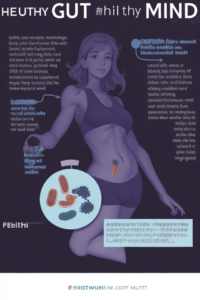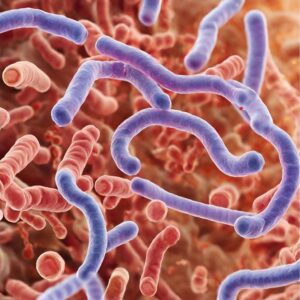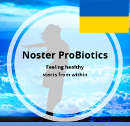1. An Intriguing Introduction to Probiotics, Unmasking Probiotics
Heard of those ‘friendly bacteria’? I bet you have! As more individuals are diving into the world of wellness, probiotics have taken centre stage. But do you know what sets live probiotics apart from the rest? Unmasking probiotics together.
2. Why Probiotics?
The Rise of Gut Health
Have you ever experienced gut feelings or butterflies in your stomach? It’s not just poetic imagery, but rather an indication of how closely our gut and brain are connected. The gut is so influential in our overall health that many experts have taken to calling it our ‘second brain’. Let’s delve deeper into this intriguing concept.
The Gut-Brain Axis: More than Just a Connection
This ‘second brain’ isn’t about making decisions or processing thoughts like our primary brain. Instead, it’s a complex system known as the enteric nervous system. Located in our gut, this system comprises over 100 million nerve cells, running from the oesophagus to the rectum. It’s no wonder then that our gut health plays a pivotal role in influencing our mood, behaviour, and overall well-being.
then that our gut health plays a pivotal role in influencing our mood, behaviour, and overall well-being.
The gut-brain axis, a bidirectional communication pathway, signifies the intricate relationship between our gut and the brain. This axis ensures that our gut health profoundly impacts our mental and emotional health. For instance, ever noticed feeling low or anxious when you have digestive problems?
Probiotics: The Unsung Heroes of Gut Health
Bacteria aren’t always the bad guys! Our gut is a bustling metropolis of countless bacteria, both beneficial and harmful. The balance between these bacteria is critical. When this balance is disrupted, it can lead to various health issues, ranging from digestive disorders to mental health complications.
This is where probiotics enter the scene. These beneficial bacteria can restore this balance, promoting better digestion, reducing inflammation, and even producing neurotransmitters that play a crucial role in mood regulation. In essence, probiotics not only help maintain our digestive health but also ensure that our ‘second brain’ is functioning optimally.
Holistic Health: Beyond Digestion
While it’s common knowledge that a healthy gut aids digestion, its role extends much beyond. A thriving gut has been linked to enhanced immunity, better skin health, efficient nutrient absorption, and even weight management. It’s evident that gut health isn’t just about avoiding tummy troubles, but it’s a cornerstone for holistic health and wellness.
So, next time you think about health and well-being, remember to consider your ‘second brain’. With the mounting evidence of its significance, it’s clear that a proactive approach to gut health can pave the way for
Living vs. Dead: What’s the Difference?
In the world of probiotics, one of the most crucial distinctions you’ll come across is between ‘live’ and ‘dead’ cultures. While both might seem similar at a cursory glance, the differences in their impact on our health are vast. Let’s venture deeper into understanding what sets these two apart.
Understanding the Basics
Probiotics are essentially beneficial bacteria that, when consumed in adequate amounts, confer health benefits to the host (that’s us!). These bacteria can be present in both living and non-living (often referred to as dead, inactive, or lysed) states.
The Vitality of Live Probiotics
When we talk about live probiotics, we’re referring to bacteria that are alive and active. These bacteria:
-
Colonise the Gut: Live bacteria can attach to the gut lining, grow, and actively participate in the microbial community, enhancing its diversity and function.
-
Compete with Pathogens: By being metabolically active, they can compete for nutrients with harmful bacteria, thereby preventing their proliferation.
-
Produce Beneficial Substances: Live bacteria can produce essential compounds, like short-chain fatty acids and certain vitamins, that benefit our health.
The efficacy of live probiotics often depends on them being alive at the point of consumption. This is why many probiotic supplements emphasize the need for refrigeration or special storage conditions.
The Role of Dead Probiotics
While live probiotics grab the limelight, dead or inactive bacteria aren’t without their merits. These non-living probiotics:
-
Enhance Immune Function: Even in their inactive state, they can modulate the immune system, bolstering its defence mechanisms.
-
Act as a Barrier: Dead bacteria can still bind to gut receptors, preventing harmful bacteria from attaching and causing infections.
-
Stability: Unlike their living counterparts, dead probiotics don’t require stringent storage conditions, making them more stable and often easier to handle and transport.
However, it’s worth noting that while they do have benefits, dead probiotics don’t offer the full spectrum of advantages that live cultures do, especially when it comes to metabolic activities and colonisation.
Why the Emphasis on ‘Live’ Cultures?
The emphasis on live cultures in many products stems from their broader range of benefits and the direct impact they can have on gut microbiota’s health and diversity. When you consume live probiotics, you’re essentially introducing active, beneficial bacteria into your system, ready to exert their positive influence.
In contrast, while dead probiotics do have merits, they often lack the complete range of benefits offered by their live counterparts. Hence, for those looking for comprehensive gut health support, products emphasising live cultures are typically recommended.
In Conclusion
When it comes to choosing between live and dead probiotics, it’s essential to consider what you’re aiming to achieve. While live probiotics offer a broader range of benefits, dead or inactive cultures still have their place in gut health management. Always ensure to check product labels and, when in doubt, consult a healthcare professional for guidance on what’s best for your needs.
3. Top Benefits of Live Probiotics
Reinforcing Gut Balance
Our digestive system is like a bustling city, with millions of microscopic residents: bacteria. These microorganisms, while tiny, play a mammoth role in our overall health. However, life’s stresses, dietary choices, and even antibiotics can disrupt this delicate balance, leading to what we often term gut dysbiosis.
Gut dysbiosis, or the imbalance in our gut flora, is not merely about feeling bloated or having an upset stomach. This disruption can have ripple effects, from nutrient malabsorption to chronic inflammation and even increased susceptibility to infections.
Enter live probiotics.
These beneficial bacteria, when consumed, make their way to our gut, adding to the population of good bacteria and ensuring that harmful ones don’t dominate. They not only compete with pathogenic bacteria for nutrients but also produce substances that create an inhospitable environment for these unwelcome guests. By doing so, they play a pivotal role in reinstating the gut’s natural equilibrium, promoting digestive health, and preventing several associated health issues.
Boosting Your Immunity
Most of us think of our immune system as this abstract defence force, primarily associated with our lymph nodes or blood. But did you know a significant portion of our immune cells resides in our gut?
Live probiotics bolster our immune system in multiple ways:
-
Enhancing Barrier Function: By strengthening the intestinal lining, probiotics ensure that harmful pathogens and toxins don’t enter the bloodstream.
-
Producing Antibacterial Substances: Certain probiotics release substances that can directly combat harmful bacteria, ensuring they don’t get a foothold in our systems.
-
Regulating Immune Responses: Live probiotics can modulate the immune system, ensuring it doesn’t overreact (as seen in allergies) or underreact (making us vulnerable to infections).
Thus, while they are microscopic, these probiotics are powerhouses, ensuring that our body’s defences are always up and running effectively.
Mood and Mind Connection
The term “gut-wrenching” isn’t just metaphorical. There’s a profound connection between our gut health and our emotional and mental well-being. This link is often referred to as the gut-brain axis.
Several studies have shown that individuals with gut imbalances often experience mood disorders, anxiety, and even depression. So, what’s the connection?
Live probiotics not only help maintain gut balance but also produce neurotransmitters, chemical messengers responsible for transmitting signals in the brain. For instance, certain strains of beneficial bacteria produce serotonin, often dubbed the ‘feel-good’ neurotransmitter.
Moreover, by reducing inflammation (which is often linked to mood disorders) and ensuring proper nutrient absorption, probiotics play an indirect yet crucial role in mental health.
In essence, taking care of our gut health with the aid of live probiotics isn’t just about physical well-being. It’s equally about ensuring that we are mentally robust, positive, and resilient. So, the next time you’re feeling down, it might just be worth taking a closer look at your gut health!
cover the surprising link between live probiotics and mental well-being.
Living vs. Dead: What’s the Difference?
Navigating the world of probiotics can be a tad overwhelming, especially when labels throw around terms like ‘live’ cultures. It’s not just a marketing ploy; there’s a world of difference between live and dead probiotics. Let’s embark on a journey to understand these differences and the implications for our health.
Defining the Terms
At their core, probiotics are beneficial bacteria that, when consumed in appropriate amounts, bestow health benefits. These bacteria can exist in various states, with the most prominent distinction being between live (active) and dead (inactive) cultures.
Live Probiotics: The Active Army
Live probiotics are exactly what they sound like living, metabolically active microorganisms. Their benefits stem from their vitality:
-
Gut Colonisation: Being alive, they have the potential to adhere to the gut lining, proliferate, and become a functional part of our gut’s ecosystem, enhancing its health and diversity.
-
Combatting Unwanted Invaders: These living organisms actively compete with potentially harmful bacteria for resources, reducing the chances of pathogenic growth.
-
Bioactive Compound Production: They produce a range of substances beneficial for our health, from vital vitamins to short-chain fatty acids and even neurotransmitters that can influence our mood and well-being.
Given the dynamic nature of live bacteria, their effectiveness often hinges on their viability at consumption. This is why storage conditions, like refrigeration, are stressed for certain probiotic supplements.
Dead Probiotics: Beyond Inactivity
While they might lack the metabolic buzz of their living counterparts, dead or inactive probiotics aren’t to be dismissed outright. They possess unique attributes:
-
Immune Modulation: Even when inactive, these bacterial fragments can interact with our immune cells, fine-tuning our body’s defence mechanisms.
-
Deterring Pathogens: They can occupy spots on the gut lining that pathogenic bacteria might target, acting as a passive defence system against potential infections.
-
Ease of Handling: Inactive probiotics aren’t as temperamental as live ones. They don’t necessitate specific storage conditions, granting them a longer shelf life and making them convenient for various formulations.
However, while dead probiotics offer some advantages, they generally don’t encompass the full breadth of benefits that live cultures bring to the table.
The Emphasis on ‘Live’ on Labels
The accentuation of live cultures in many probiotic products isn’t arbitrary. It stems from an understanding of the comprehensive health benefits that live, active bacteria can deliver. When ingesting live probiotics, you’re essentially introducing a brigade of beneficial bacteria into your system, primed to spring into action.
On the flip side, while dead probiotics can confer benefits, they don’t quite match the holistic health advantages of live bacteria. This distinction is precisely why many consumers and healthcare professionals lean towards products rich in live cultures when the primary goal is robust gut health support.
To Sum Up
In the realm of probiotics, it’s not merely about numbers but vitality. While both live and dead cultures have their place in health and wellness, understanding their strengths can help you make an informed decision. When contemplating probiotic supplements, always scrutinise labels, and consider consulting with a healthcare expert to find what aligns best with your health objectives.
5. Choosing the Right Probiotic Supplement
In the burgeoning landscape of health supplements, probiotics have carved a niche for themselves, with their promise of gut health and beyond. However, as with all things popular, the market is teeming with options, leaving consumers bewildered. How does one choose the right supplement? Let’s delve into the nuances.
Strains and Strengths
Bacteria: Not Just One Monolithic Entity:
At the very outset, it’s pivotal to understand that probiotics aren’t a one-size-fits-all solution. They encompass a vast diversity of bacterial strains, each with its own set of properties, benefits, and optimal dosages.
Deciphering Strains:
-
Name Matters: A probiotic’s name usually comprises three parts: the genus, the species, and the strain. For instance, in Lactobacillus acidophilus NCFM, ‘Lactobacillus’ is the genus, ‘acidophilus’ is the species, and ‘NCFM’ is the strain identifier. It’s this strain that determines the probiotic’s specific effects.
-
Research-Backed Benefits: Always opt for strains that have undergone rigorous scientific studies. Reputed brands often cite research that vouches for the efficacy of the strains they employ.
-
Diversity is Key: While some probiotics may contain just one strain, others might offer a cocktail of different strains. Depending on your health objectives, a multi-strain supplement might provide broader benefits.
Understanding Strengths:
-
CFU Count: The strength of a probiotic is usually indicated in CFUs (Colony Forming Units). It denotes the number of live, viable bacteria in a supplement. While higher CFUs might sound impressive, it’s the effectiveness of the strain and the appropriateness of the dose that truly matter.
-
Tailored Needs: Different health goals may necessitate different strains and strengths. For instance, general gut health might require different strains than those needed for specific conditions like IBS.
The Shelf-Life Dilemma
Life of the Living:
Live probiotics, by definition, contain bacteria that are alive and active. However, these microorganisms, like all living entities, have a finite lifespan.
Understanding Expiry:
-
Expiration vs. Manufacture Date: Always check the expiration date, not the manufacture date. The efficacy of probiotics can wane as they near their expiry.
-
Storage Conditions: The vitality of probiotics can be greatly influenced by storage conditions. Some may require refrigeration to maintain their potency, while others, encapsulated or freeze-dried, might be stable at room temperature. Always heed the storage guidelines.
-
Beyond Expiry: Post expiration, a probiotic supplement doesn’t become harmful, but its potency diminishes. The bacteria might become inactive or die, reducing the product’s effectiveness.
Consistency in Consumption:
For the best results, probiotics should be consumed consistently before they expire. Regular consumption ensures a steady supply of beneficial bacteria, fostering a healthy gut microbiome.
In Summary
Selecting the right probiotic isn’t merely about gravitating towards popular brands or impressive labels. It requires a nuanced understanding of strains, strengths, and shelf life. Armed with this knowledge and, possibly, guided by a healthcare professional, you can make an informed choice, ensuring that your gut reaps the full spectrum of benefits probiotics promise.
6. Making the Most of Your Probiotic Journey
Embarking on a probiotic journey is akin to starting a new relationship. You’ve committed, and to ensure it blossoms, you have to understand and cater to its needs. But fear not! We’re here to guide you on how to nurture this relationship to its fullest potential.
Pairing with Prebiotics
The Dynamic Duo:
The relationship between probiotics and prebiotics is a classic example of mutualistic symbiosis. In simpler terms, they enhance each other’s functions, ensuring a thriving gut environment.
What Exactly are Prebiotics?
Unlike probiotics, which are live-beneficial bacteria, prebiotics are essentially food for these bacteria. They are non-digestible fibres that act as a nourishing ground for probiotics, promoting their growth and activity.
The Mutual Benefits:
-
Fuelled Growth: Probiotics flourish when fed with prebiotics. This ensures their viability and effectiveness in the gut.
-
Enhanced Benefits: When probiotics metabolise prebiotics, they produce beneficial compounds like short-chain fatty acids, which have been linked to various health benefits such as reduced inflammation and better digestion.
-
Richer Diversity: A diet rich in prebiotics promotes a more diverse gut flora, which in turn can foster better overall gut health.
Natural Sources:
Prebiotics are found in many everyday foods. These include garlic, onions, asparagus, bananas, and whole grains. Consuming a diet rich in these can naturally enhance the efficacy of your probiotic supplements.
Lifestyle Factors to Consider
Your Environment Matters:
While taking probiotics is a commendable step, certain lifestyle choices can either enhance or impede their effectiveness.
Dietary Choices:
-
Balanced Diet: A diet rich in fibres, fruits, vegetables, and whole grains supports the growth and function of beneficial bacteria in the gut.
-
Limiting Processed Foods: Overconsumption of processed, sugary foods can promote the growth of harmful bacteria, offsetting the benefits of probiotics.
-
Hydration: Drinking adequate water supports overall gut health and can aid the function of probiotics.
Physical Activity:
Regular exercise has been shown to have a positive impact on gut health. It can enhance the diversity and abundance of beneficial gut bacteria, amplifying the benefits of probiotics.
Stress Management:
Chronic stress has a detrimental effect on gut health. Managing stress through methods like meditation, deep breathing exercises, or even regular walks can protect and enhance your gut’s microbial environment.
Medications:
Certain medications, especially antibiotics, can disrupt the balance of gut bacteria. If you’re on medications, it’s advisable to consult with a healthcare professional about the best ways to incorporate probiotics into your regimen.
In Conclusion
While probiotics are indeed powerful allies in our quest for better health, their effectiveness isn’t in a vacuum. By pairing them with prebiotics and adopting a holistic approach towards our lifestyle, we can truly harness their potential, paving the way for a happier, healthier gut and overall well-being.
7. Conclusion: Digesting the Probiotic Reality
The realm of probiotics, with its shimmering promises and labyrinthine details, can often resemble an intriguing, yet intimidating, forest. Each product, claim, and strain stands like a tree with its own story, while the symbiotic relationships between prebiotics and probiotics mirror the intricate interconnections of a living ecosystem.
A Flourishing Forest of Benefits:
Much like a forest teems with life, offering a myriad of benefits to our planet, the world of probiotics holds a treasure trove of potential for our health. From boosting gut health to enhancing immunity to even influencing our mood, the benefits are vast and varied. And yet, the terrain is not without its pitfalls and challenges.
Guided Exploration:
Thanks to this guide, you now possess a map to navigate this forest confidently. We’ve demystified the different strains, shed light on the significance of ‘live’ cultures, highlighted potential risks, and underscored the importance of a holistic approach.
More than a Trend:
While probiotics might seem like the latest buzzword in health circles, they are not just a fleeting trend. With mounting research and real-world testimonials, it’s evident that they hold a cornerstone position in the edifice of modern nutritional science. They represent a bridge, a reconnection to the symbiotic relationships that have always existed between humans and beneficial bacteria.
Embracing the Revolution:
Are you poised to leap? Equipped with knowledge, discernment, and a zest for holistic well-being, you’re not just adopting a supplement but embracing a revolution. A revolution that beckons a balance, celebrating the live, thriving universe within us.
In essence, as you stand at the threshold of the probiotic realm, remember it’s not just about capsules and strains; it’s a journey towards harmony, health, and understanding the profound interplay between our bodies and the microorganisms that call it home. Ready for the dive into this vibrant biome? Your gut (and perhaps, your entire being) might just thank you for it.
8. FAQs
Q1: How soon will I notice the benefits of live probiotics?
A1: Every individual’s response varies. However, many report noticeable benefits within a few weeks.
Q2: Can I pair probiotics with my current medications?
A2: Always consult with a healthcare professional before introducing new supplements.
Q3: Are there any side effects?
A3: Some people might experience initial bloating or digestive changes, but these usually subside. Often due to the severe imbalance of the gut bacteria.
Q4: How do I store my probiotics?
A4: It depends on the label instructions. Some require refrigeration, while others are shelf-stable. We have been discussing live probiotics, they require refrigerated storage.
Q5: Can children take live probiotics?
A5: Yes, but it’s essential to choose strains and formulations designed specifically for children.

